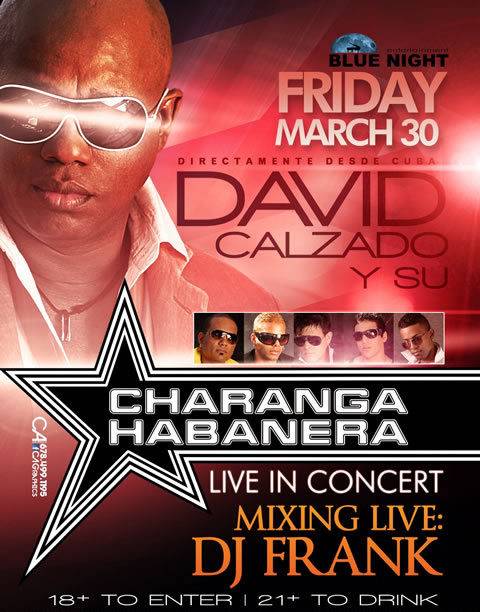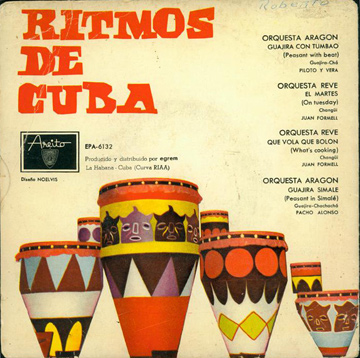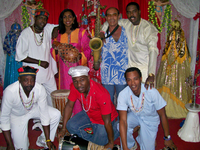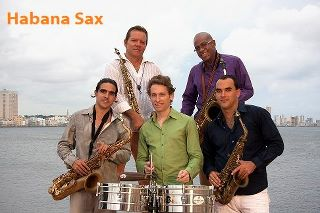Archivo
Lo Nuevo[hide]
Reportes: From The St... : Cubadisco 2...
Fotos: Tom Ehrlich
Staff: Kristina Lim
Musicos: Juan Formell
Musicos: Yordamis Megret Planes
Musicos: Yasser Morejón Pino
Musicos: José Luis "Changuito" Quintana...
Musicos: Dennis Nicles Cobas
Fotos: Eli Silva
Grupos: Ritmo Oriental : 1988 - Vol. IX - 30 a...
Musicos: Rafael Paseiro Monzón
Musicos: Jiovanni Cofiño Sánchez
Fotos: Tom Ehrlich : 2024 Monterey Jazz, P...
Resenas: Vacilón Santiaguero (Circle 9 ...
Fotos Del Día [hide]
Sin Clave No Hay Na
Charanga Habanera in the Midwest

Those of you within traveling distance of Louisville, KY can see Charanga Habanera on Friday, March 30 at the Coconut Beach Nightclub, now in a new location at 2787 South Floyd St., Louisville KY. Advance tickets (cheaper than at the door) may be purchased at
https://www.ticketriver.com/event/3218-charanga-habanera-2012-kentucky-tour
continue reading Sin Clave No Hay Na
Timba and The United States, Part II
The Initial Reception of Timba in The United States
La Timba y Los Estados Unidos, Parte II: La Recepción Inicial de la Timba en los E.E.U.U
(Para leer este artículo en español oprima aquí)
If musical merit was the only ingredient necessary for mass popularity in the United States, Timba would have quickly taken the country by storm the same way that the Mambo did years earlier. However, that is not enough, as many Jazz musicians have also learned the hard way over the years. An infrastructure to support the music is also required for any genre to reach large numbers of listeners, and that was not in place for Timba when its sounds first reached the United States. In order to fully understand the reasons for this, we first need to briefly revisit the three decades prior to Timba’s emergence as a distinct style.

In the 1960s, there was no significant ongoing cultural exchange between the United States and Cuba. This does not mean that there was no exchange of ideas of any sort - musicians both here and there were listening to each other by various means, and radio enthusiasts such as this writer were keeping up with what was happening in Cuban music via shortwave stations such as Radio Habana Cuba, Radio Rebelde etc. However, most of the general American public remained....click "continue reading" below for the full article
continue reading Sin Clave No Hay Na
Happy International Women's Day!
Today is International Women's Day, so here's a shout out to all of the women in the music, past and present, especially Orquesta Anacaona, Cuba's all-female band that is still going strong after 80 years with a new generation of performers:
continue reading Sin Clave No Hay Na
Los Hermanos Arango and Habana Sax in the US!
Coming Soon: Interactivo
Three phenomenal groups from Cuba are performing in the US in short order:
 Los Hermanos Arango are at the Berklee Performance Center at 8:15 pm Eastern Time on Tuesday, February 21. Can't get there? No worries, the performance will be carried by a live video stream! Here is this link for the live stream::
Los Hermanos Arango are at the Berklee Performance Center at 8:15 pm Eastern Time on Tuesday, February 21. Can't get there? No worries, the performance will be carried by a live video stream! Here is this link for the live stream::
http://goo.gl/Yyp9V
 Next up: Habana Sax, which is scheduled to perform in Miami at the Art of Freedom/La Cueva Azul, 1388 SW 8th St., Miami FL on Friday, 24 February and Saturday, 25 February. Call the venue for performance times at (305)-857-9848.
Next up: Habana Sax, which is scheduled to perform in Miami at the Art of Freedom/La Cueva Azul, 1388 SW 8th St., Miami FL on Friday, 24 February and Saturday, 25 February. Call the venue for performance times at (305)-857-9848.
Finally, Interactivo is scheduled for a concert in Miami Beach on Sunday, 1 April at 7PM at the North Beach Band Shell (Collins and 73rd St., Miami Beach.). For more details, click continue reading to see the official flyer or see the Fundarte announcement a http://goo.gl/xtZjJ
continue reading Sin Clave No Hay Na















